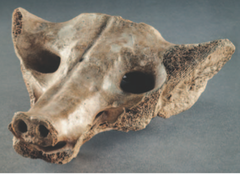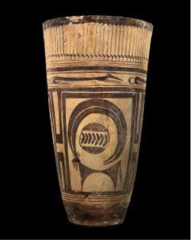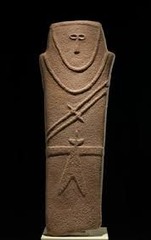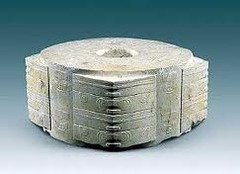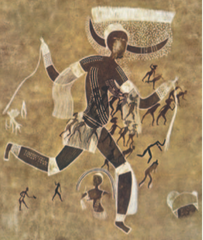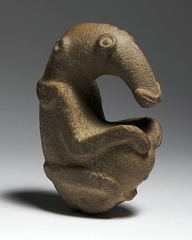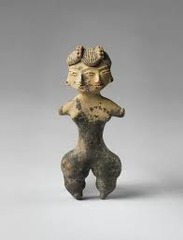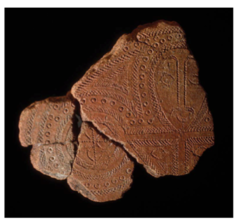Hunter King; Unit 1: Prehistoric Art
Apollo 11 Stones
Period: Unit 1: Prehistoric Art
Artist: unknown
Date: 25,500-25,300 B.C.E.
Function: no clear information, could be symbolic for language or writing, could be used for ritualistic purposes
Form: rock painting and engraving or incising, twisted perspective, no clear picture of the animal, not identifiable
Content: stone slab/tablet with some type of canine or feline
Context: art of time period
Medium: Charcoal on stone
Patron: unknown
Location: Nambia
Camelid sacrum in the shape of a canine
Period: Unit 1: Prehistoric Art
Artist: unknown
Date: 14,000-7,000 B.C.E.
Function: Used for hunting magic or religious mask
Form: piece of bone used to carve a skull
Content: carved skull of a canine's head in bone
Context: used for good luck during a hunt or used for ritualistic purposes
Medium: Bone
Patron: unknown
Location: Tequixquiac, central Mexico
Beaker with Ibex motifs
Period: Unit 1: Prehistoric Art
Artist: unknown
Date: 4,200-3,500 B.C.E.
Function:burial piece, found in cemeteries
Form: linear patterns, geometric shapes, exaggerated elements of figures, twisted perspective, decorations mimics shape
Content: cup with animal figures
Context: used for burial purposes, goats or animals are important
Medium: Painted terra cotta, clay
Patron: unknown
Location: Susa, Iran
Anthropomorphic stele
Period: Unit 1: Prehistoric Art
Artist: unknown
Date: Fourth millennium B.C.E.
Function: served as an idol, or a grave marker for someone who died, a guardian
Form: elements that emphasize height, lines follow curve shows dimension, stylized, geometric, symmetrical
Content: human like figure made of stone
Context: guardian figure, early piece from Arabian Peninsula
Medium: sandstone
Patron: unknown
Location: Arabian Peninsula
Jade cong
Period: Unit 1: Prehistoric Art
Artist: unknown
Date: 3,300-2,200 B.C.E.
Function: piece used for religious ceremonies
Form: symmetrical, circle inside of square, hole through center, line patterns, face motif, incised lines, suggest register
Content: Carved jade with a circle in a square, registers
Context: Early Chinese jade piece used for religious or ceremonial purposes
Medium: Carved jade
Patron: unknown
Location: Liangzhu, China
Stonehenge
Period: Unit 1: Prehistoric Art
Artist: unknown
Date: c. 2,500-1,600 B.C.E.
Function: used for worship, astronomical clock, clock
Form: post and lintel construction, stones put in place with purpose, used tenon and mortise to keep stones on place
Content: large stones purposefully placed in a circle
Context: arranged in circular pattern for burial site or astronomical clock, early Neolithic
Medium: Sandstone, megalift
Patron: unknown
Location: Wiltshire, UK (Neolithic)
Running horned women
Period: Period: Unit 1: Prehistoric Art
Artist: unknown
Date: 6,000-4,000 B.C.E.
Function: religious ceremony, hunting, fertility
Form: heads are round, divine horn, outlined in white, rain or grain, stylized
Content: women running with horns
Context: early African piece, used for rituals
Medium: Pigment on rock
Patron: unknown
Location: Tassili n' Ajjer, Algerian
Great Hall of the Bulls
Period: Period: Unit 1: Prehistoric Art
Artist: unknown
Date: 15,000-13,000 B.C.E.
Function: used for rituals, hunting magic for a better success for the hunt, hunter gathering
Form: Animals are in profile, twisted perspective to see horns and far legs, animals are dark, light background
Content: a scene of animals perhaps not trying to be caught by a hunter
Context: Paleolithic piece representing the hunt for animals or rituals the animals served for
Medium: Rock painting
Patron: unknown
Location: Lascaux, France
The Ambum Stone
Period: Unit 1: Prehistoric Art
Artist: unknown
Date: c. 1,500 B.C.E.
Function: mortars, pestles, freestanding figures, religious ceremony
Form: handheld, geometric, smooth, bilateral symmetry, pestle, oval center
Content: pestle in shape of an animal
Context: Early Pacific art for religious or ritualistic purposes
Medium: Volcanic rock, Greywacke
Patron: unknown
Location: Ambum Valley, Enga Province, Papua New Guinea
Tlatilco female figure
Period: Unit 1: Prehistoric Art
Artist: unknown
Date: 1,200-900 B.C.E.
Function: burial, fertility, represent twins
Form: curved lines, geometric, no distinct hands or feet, wide hips, details in hair or hat
Content: distorted piece of a two women
Context: Early piece in Mexico, ceramic piece to represent fertility or burial
Medium: Ceramic
Patron: unknown
Location: Central Mexico, site of Tlatlico
Terra cotta fragment
Period: Unit 1: Prehistoric Art
Artist: unknown
Date: 1,000 B.C.E.
Function: used as a ritual tablet, used for worship, religious
Form: No set shape, dotted lines to create images, linear and geometric, red pattern, chiseled
Content: doted lines on terra cotta to show images
Context: Pacific early piece, used for worship and rituals
Medium: Terra cotta
Patron: unknown
Location: Lapita, Solomon Islands, Reef Islands

